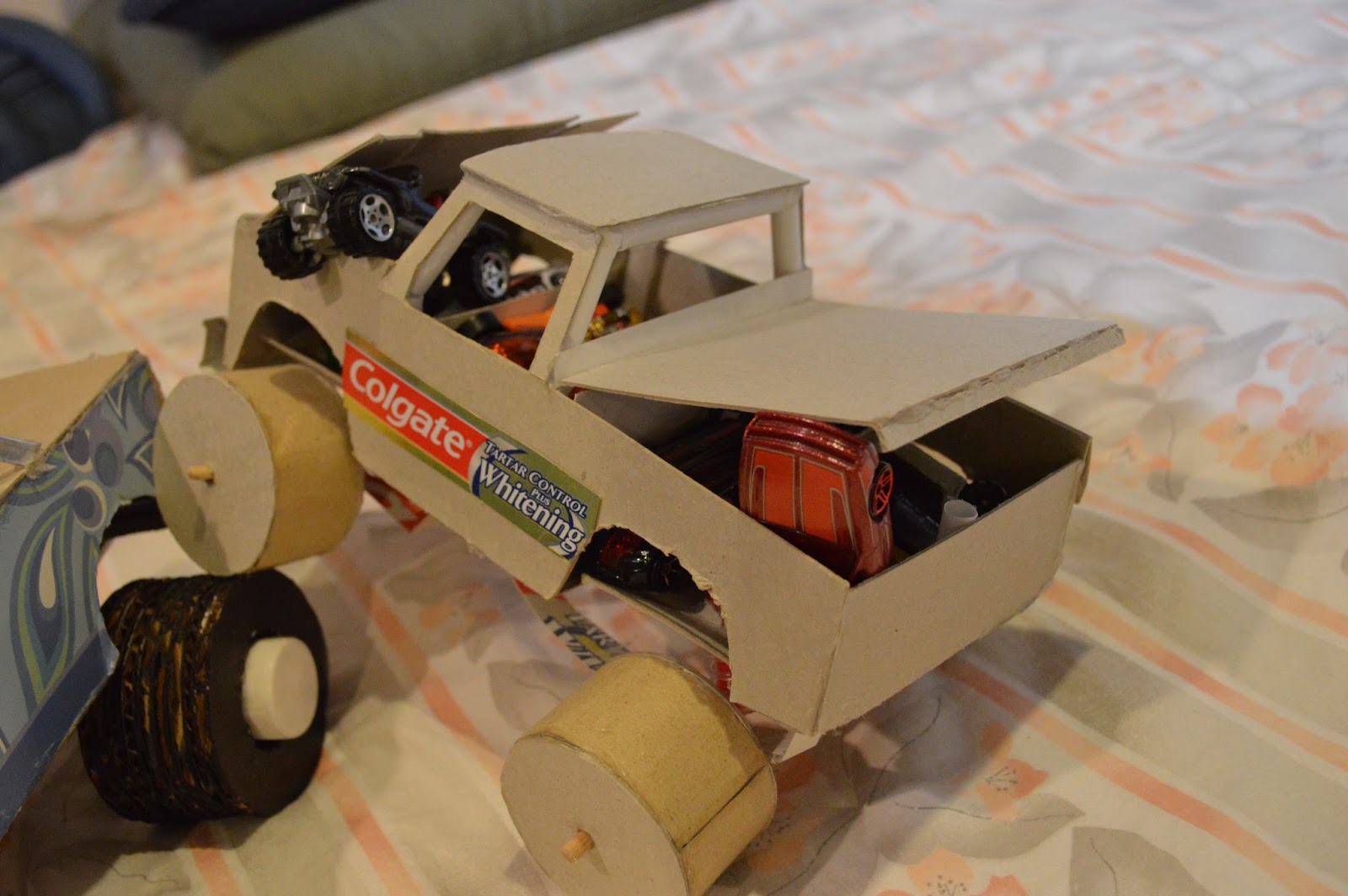Slowly, the construction paper turned into cardboard and Scotch tape became duct tape or hot glue. More of my crafts started having a more functional or practical purpose. I made portfolios for artwork, boxes to carry gadgets, and gridded trays to carry Hot wheels cars. This skill with paper and cardboard comes in handy pretty often and it is nice to have in the studio classes at the architecture school.

In 8th grade, I took a basic art class for fun. Our last project was supposed to a sculpture but I'd decided that I wanted a functional model of a car. The result was the blue pickup truck on the left with a body made from a hot glued Kleenex box, straw suspension, and springs made from a spiral notebook. The wheels were probably the most time-consuming parts to make: I had to cut many circles out of corrugated cardboard to layer them up (to look like tire tread). It even had leather seats and other details snatched from the scrap box.
Parts have fallen off, namely a few of the blue silicone keyboard spring things
The whole thing was pretty rickety. The Kleenex box cardboard was flimsy, my "roll cage" didn't go to the floor, and the wheels were extremely heavy which made the axles wobble a ton. The wheels would tear at the suspension and rub on the edges of the wheel wells. I had to make trailing arms to locate the axles fore and aft. Since cardboard only has tensile strength but instantly bends upon compression, the lack of arms behind the rear axle makes this truck nearly impossible to roll backwards. The suspension was functional though and the near friction-free straws made it so that the bamboo stick axles could easily rotate.
The flag on the blue truck was a mandatory name tag for class
By now, you're probably thinking the gray truck in these photos must be an improved version and if so and you'd be correct. I had some better ideas after school ended so I followed the same principles but made improvements where they were needed.
This time, the wheels were hollow so as not to put excessive strain on the straw suspension. I added suspension arms behind the rear axle, creating a W shape side profile and making sure neither axle could move forward or backward. The roll cage on the new truck was measured more precisely and the straws went to the floorboard to make the roof stiff. I can actually carry this truck by its roof, toss it around, and compress the suspension by pushing on the roof without worrying a single bit. This truck is extremely strong (relative to my cardboard craft standards), no doubt helped by the fact that I used stiffer cardboard. I don't remember ever having to fix the gray truck before.
One of the positive effects I envisioned of building functional suspension was that I could run it over rough surfaces and still watch the truck ride smoothly. There is a strange pleasure associated with watching Baja trucks fly over rocks and ruts on the desert path, wheels bouncing up and down while the vehicle continues traveling horizontally at 100+ mph. The same goes with my toys; however, with the light weight of this truck, that didn't really happen. I already foresaw this problem before beginning the project and I made it so that I could put Hot wheels cars into the engine bay, cab, and bed of the truck to weigh it down for this purpose. Hinges are just Scotch tape.
The "driving" characteristics of the gray trucks are much more realistic than those of the blue truck. Because of the weight of the solid wheels, the blue truck never flew off ramps or anything. It came crashing down and rather than bouncing off the ground, the wheels just wobbled around and looked as if they would be torn out of the truck. When flexing the suspension as four-wheelers like to do to show off (above), the blue truck's wheels can remain on the ground, as seen in the second photo on this post. That's because the wheels are so heavy that they pull down on the suspension. On the other hand, the gray truck is way too light to do this by itself but with the help of the Hot wheels, it creates weight to push down on the suspension in order to make all wheels touch the ground just like a real truck would do.
Most people would probably think I'm silly for doing this, for putting so much thought and time into childish crafts but I really hope I never grow out of this. I'm just worried about having space to store them. The gray truck is tons of fun to play with and I was planning to make a sedan, a '64 Ford Galaxie specifically, but never got around to finishing it. I could probably do that this summer after the bike project. We'll see.





No comments:
Post a Comment